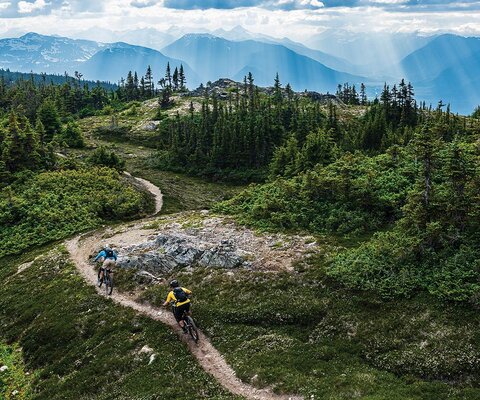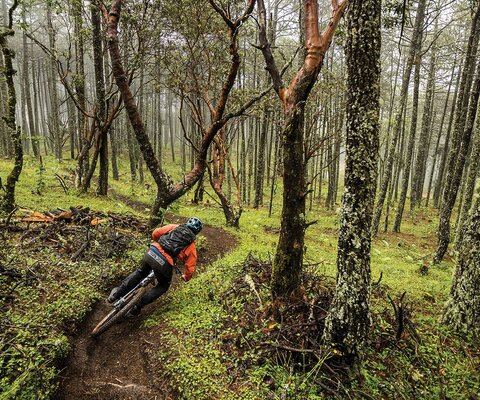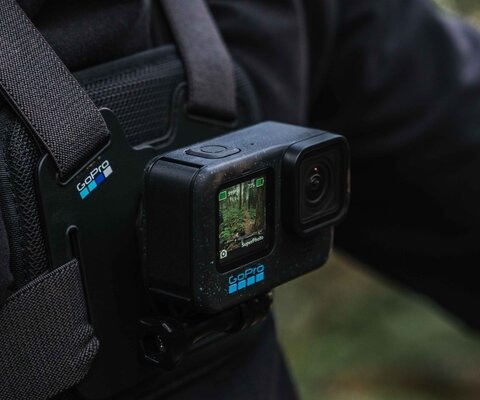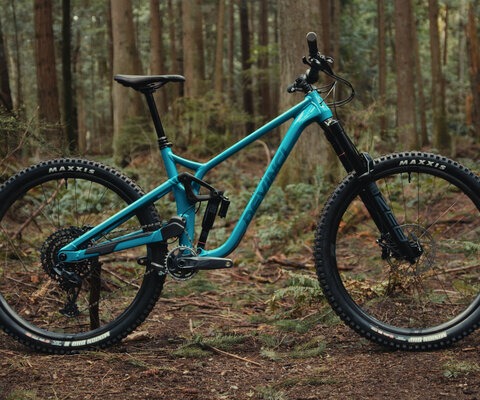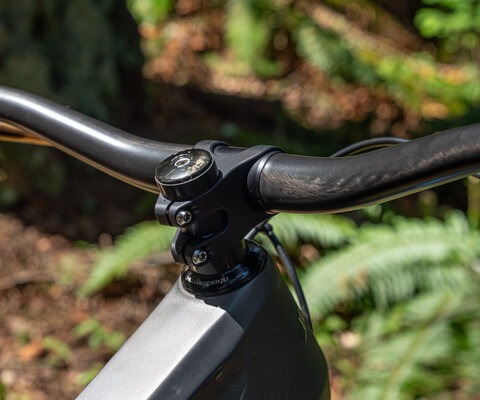No-Mad's Land - Argentina by Bike with Mike Kinrade and John Wellburn
There are no defensive drivers in Chile. Only offensive, and your fate is in their hands.
The traffic in Santiago is relentless, tenacity matched only by the customs officials who had forced me to pay multiple tariffs upon entering the country. The buildings lining the snarled streets—and the streets themselves—are decades away from the title “modern,” and I can only describe the mood pervading the whole scene as raw. It’s the sense that if you mess up, it’s going to hurt a lot more than back home.
I’m riding in an old Korean cargo van, property of photographer and adventurer extraordinaire John Wellburn, who picked me up from the Santiago International Airport a few hours prior. John spends half his North American summers in Williams Lake, BC, fleeing to Mendoza, Argentina when winter strikes. We’ve known each other for a long time, and this will be one of the most impressive out of our many excursions.
It’s February, and snow totals are stacking up in BC. John and I have been toying with the idea of an exploratory trip into the Chilean Andes for a while now, and John assures me the potential for all-time riding—and adventure—is dialed to 11. The problem? Some of the areas are difficult to access via 4x4, much less cargo van.
John and I also both love motorcycles, and so we’ve developed a plan: we’ll borrow a pair of motor bikes from some of John’s friends in San Rafael, use John’s down-home engineering skills to build bicycle racks, and head as deep into the hopeful zones as our two-strokes steeds will take us. It has the makings of a truly Wellburn-esque adventure…or of a painful South American tragedy.
As we leave the chaos of the city and head into the mountains, the feeling of rawness doesn’t disappear—in fact, as we wind our way higher into the Andes and eventually into Argentina, farther from the structure and security of civilization (even as rough as Santiago’s), it only grows. We are on our own here.
We are sitting at 15,000 feet in Las Cuevas, Chile, and all around rise huge, rugged mountains. The Andes are seemingly endless in their north/south march, insurmountable and un-rideable, but one section has been smoothed over eons by the harsh, windy alpine climate. Amid the procession of rocky spires it’s a mountain biking oasis.
Las Cuevas is a truck stop/tourist township along a fuzzy section of the Chile/Argentinian border, with a tiny seasonal population and just over a dozen permanent residents. Despite its perch in these mountains, to the citizens the idea of biking in the area is completely alien, but as we settle into the hamlet’s hostel the owner is friendly and definitely not shy. He cranks the volume on his stereo, trying to impress us with his music library…and, despite the remoteness of this place, he does a pretty damn good job.
At first light we make our way up the most prominent ridge above the town, our feet sinking a six inches into the pumice-esque ground with each step and the lack of oxygen immediately taking its toll. It’s a brutal climb, and at the ridge’s summit we catch our breath, survey the immense terrain, and prepare to drop in, uncertain of what to expect.
I picture something Utah-esque, but this is completely different—solid, fast and it only takes a few slashes and compressions to get the feel of this entirely new ground. It’s as far from the tacky loam of home as possible—and it’s incredible.
Standing on the ridge at the end of the day, low sun reveals a vastly different landscape across the valley, house-sized rocks scattered by what looks like a volcano erupting underneath a glacier. We decide it needs to be ridden.
The next morning we get up for a frigid sunrise and shed our 30 pounds of old wool blankets to return to the boulder field. As we ride through the monstrous stone sentinels, we soon find ourselves on an obviously established trail, worn in by decades of footsteps rather than shovels or machinery. This is more than a game trail, but a pathway following the once-famous Trans-Andean Railway, which connected the Argentinian city of Mendoza with the Chilean city of Los Andes but was destroyed by avalanches in 1984. Head west, and you will reach Chile; east, and it will pass through numerous small villages before revealing an ominous view of 22,841-foot Aconcagua, the highest peak in South America. It’s an intimidating setting, but only enhances the wonder of the single track following the railway. It’s some of the best I’ve ridden in a long time.
The weather and terrain have been perfect, but the journey must continue, and we pack up with a plan to revisit Las Cuevas. First, however, we must procure our transportation for the rest of the trip, and build the racks that will haul our mountain bikes into the literal no-man’s land of the next leg of our journey. We spend the four-hour drive to San Rafeal, our base for readying the dirt bikes, talking about plans for the racks and places to camp, all the while dreaming about the potential lines hidden in the depths of these mountains.
Our highway reverie is interrupted by a grinding noise from John’s van, and suddenly he’s fighting to get in gear. He fails, and minutes later we are standing on the side of the road, stranded.
Being a complete gringo, I ask a very gringo-esque question: “Can we just get a tow truck to a shop, then rent a car?” John humors me—not likely, but we can try, he says. His face however, betrays both the stupidity of my question and the truth of the situation. We are going to have to fix this ourselves.
Hours later, hands stained with oil and jittery from gas-station coffee, we are back on the road—with third gear as the lone weapon in our arsenal. Considering the alternatives, it’s a good one to have.
We make it to San Rafael at midnight and set up camp at our newest base: Chateau ……well, I can’t give the official name, as the occupants like to keep a low profile for security reasons. This is John’s friends’ compound and the source of our motor bikes, and after we win the trust of the guard dogs we set up tents and drift off into well-deserved sleep.
Breakfast the next morning consists of coffee, biscuits and conspiracy theories, all served with friendly down-South-‘Murican hospitality. Our hosts are ex-pat pioneers: the family, led by “George” (as we call the father), has uprooted their lives of “US vanity and overwhelming federal laws,” he says, “for a simpler, fend-for-yourself lifestyle,” and with hard work turned a barren piece of land into their own personal oasis.
The motor bikes wait in George’s impressive garage, and as we walk inside John, an experienced welder, points out a variety of welding machines, chop saws, drill presses and piles of scrap metal. It’s the perfect place to rebuild a truck—or jury-rig a rack to carry bikes, camera gear, and supplies thousands of miles along battered Argentinian highways in the depths of the Andes.
Two days of frantic ingenuity and iron-working sorcery later we load our motor bikes with all our water, food and fuel and pull back onto the crowded city streets. Hours and miles pass, and we leave the traffic and road signs behind as the road turns from pavement to dirt. We reach our first campsite—another stunning mountain sanctuary—40 more minutes down the road, but we’re up early the next morning with little time to enjoy it. The day’s mission is ambitious: five hours of off-roading through the alpine desert, winding up through giant plateaus, beautiful in ways completely foreign to British Columbia.
Wildlife here has been dealt a bad card. Not much survives at all, and what does must constantly search for food and water—and if they succeed, there’s a good chance something else has beat them to it…or is using it as bait. Humanity is equally sparse. The only person we meet comes on us suddenly as we round a corner, a man on a horse, holding a rifle and theoretically tending his sheep. There is nothing else for us to do but wave, and the armed rancher doesn’t even flinch in response. Still, surrounded by miles of emptiness, it is better than nothing…if a little creepy. We gas the bikes as we pass, eager to be on our way.
Many hours of stunning views and saddle-sore later, we arrive at jumble of ruins and set up camp. The rows of stone walls resemble an abandoned military building, but also create sheltered pockets for tents and stoves—a good thing, because heavy winds start battering us and don’t stop, and even with the cover, articles of clothing, food and supplies get torn away. Behind us, a silt-filled stream drains from a small glacier; beautiful, but sand and drinking water are not an ideal mix.
John and I spend the night lying awake in our tents, fighting the wind. Even with the 30-pound rocks stacked in our shelters’ corners, the nylon bloats like a skydiver’s parachute, and there is little need for alarm clocks when the sun finally peaks over the jagged horizon. Neither of us have slept at all.
The view upon exiting the tents, however, banishes any sleep from our bleary eyes. Early morning light bathes the small glacier, revealing a thread of single track dropping off into the distance—this is what we’ve been searching for, and we hop on our bicycles and pedal off.
The ride is easily worth the previous night’s sleeplessness, as the trail winds through natural hot springs and high-alpine amphitheaters, peppered with rocks and tenacious vegetation. We finish at one of the many geothermal pools, gabbering about how incredible the descent was. It’s enough that the armed Argentinian soldier waiting at our tents when we return doesn’t faze us…well, not really. Despite the area being by all appearances uninhabited, Chile and Argentina are constantly arguing over this stretch of border, and both countries’ armies make the occasional patrol. Sometimes these troops can be quite corrupt and extremely hard to deal with; this soldier, however, is just happy to have someone to talk to.
Hours away from the nearest amenities, the question of whether we have enough gas is a very legitimate—and serious—one. Still, the day before we had spotted a line a mile or so away, a beauty of a descent of questionable sketchiness levels. We decide we have enough gas. A line like this is worth the risk.
Two hours of motoring and hiking later, I am standing at the drop-in zone, two eagles diving at me as I stare down what is an even-more-hairball line than it appeared from afar. But I’m here, and this is the way down. I prep myself and push off, away from the attacking eagles and towards the valley floor far below.
In the world of mountain bike photography, sometimes getting the shot means doing things that in other situations would seem stupid…and foolishly dangerous. This is one of those times. It rides well, and is an amazing feeling to tick off another first descent, but this is a survival line. I am content with one lap.
It’s a long walk back to the motor bikes from the bottom, and the thought of another four hours of off-roading—and the possibility of running out of fuel and having to carry our motor bikes through the desert—thoroughly occupies my mind. But this is why we are here, to throw the dice and push the boundaries of what’s possible. It helps that we have no other choice.
Fuel burns fast on our journey back to the paved road and onto Malargüe, a relatively large city of 25,000 where John and his girlfriend have an apartment, and we sputter in on fumes. We gambled and won, and despite sleep-deprivation and frayed nerves we are all smiles—exhausted, hungry smiles. Even the disturbing sound of feral dogs is like a lullaby.
In a pinch, with a little fiddling empty soda cans and alcohol can make for great stoves, and the next morning we brew a cup of coffee and return to the road. The destination is once again Las Cuevas and the first zone of the trip, to the lines we had so longingly left 12 days before.
International mountain bike trips, especially those into new, wild places, are usually lessons in Murphy’s Law, but up to this point our trip has been fairly easy. Murphy, however, has not forgotten us. The high Andean desert receives about two inches of precipitation a year; which, as we are suddenly hammered by a mid-summer storm, is hard to believe. It is absolutely dumping.
We’ve come too far to stop or turn back, so we motor through the weather to Las Cuevas and refuge. John and I settle back into our room at the hostel, this time welcoming the worn-out mattresses and dozens of pounds of scratchy wool blankets. We can barely even compliment the hostel owner on his newest playlist before passing out in exhaustion.
With clear goals set during our previous visit, there is little hesitation as we pedal from the village towards the top of the first line. The familiar frigid temperatures once again mix with the thin, high-altitude air to tax our already tired bodies, but as we reach the summit and look down any doubts we had vanish. The line is beautiful, filled with playful natural features and room to slash and turn. Coming back was a good idea.
The weather teases us over the next few days with the hope of clear, warm skies, but with frustrating regularity the clouds and high winds roll in during the early afternoon and discourage our attempts at evening laps. Still, we are far from disappointed, sticking to morning rides and even taking advantage of a fullmoon for midnight turns.
Our trip is coming to an end, and we still feel there is so much more to do. We decide we can’t wait for the mountains to grace us with perfect weather, and each of our remaining days we push over another ridge, ticking off new lines that are completely different than the last. One has a mellow grade with grippy ground; the next is packed dirt embedded with sharp flakes of rocks, a natural cheese grater, with abundant technical lines to every side. As we make our last descent back to our cold little hostel I am struck by the potential here—I imagine new trails falling from every ridgeline, using the abandoned train tracks as a backbone of access that leads back to the quaint, nearly abandoned town site of Las Quervas. There is no end.
The next morning, those same mountains—dreamy the day before—lash out, swapping sun for another snowstorm and reminding us how truly insignificant we are in this place. The highway has already washed out from the previous storm, and if we don’t get out soon we will be blocked by the next inevitable slide. We rush to load our motor bikes and prepare for the trip out of the mountains to San Rafeal…but, as the storms advances above, Murphy strikes again and they refuse to start. Combustion needs oxygen and there is very little here.
In a display of the mechanical sorcery that created our motor bike racks, John sweet talks the machines into starting, and we struggle through the next four hours of frigid hardship. We pass vehicles stuck in the mud and gas stations with hour-long lineups, and we just slip past as officials set up a road block—the highway has washed out again. Soon we enter San Rafael and the city madness within, and we breathe a sigh of relief as the door to George’s compound rolls back and we motor the bikes into safety.
The family’s hospitality hasn’t diminished, and we are showered with quiche and questions about the journey. However, I have only a half-hour to get to the bus depot that will return me to Santiago and my plane home. We say our goodbyes—John and I cannot be more grateful for the help George and his family has given us, and I cannot be more grateful for John’s work to make this happen. We have succeeded, pushing into the unknown and riding lines that have never seen footsteps, much less tire treads.
The only thing to say is goodbye and thank you. As I load the bus a half-hour later, looking an absolute gringo in long underwear, hoodie and high-top biking shoes—the only dry gear I have—the rawness I felt upon my arrival is still there. However, this time it’s different. Because after days on our own, in some of the most brutal heights of the Andes, I realize it’s that rawness that makes for true exploration.
